An In Toto Approach to Radon Dispersion Modelling from a South African Gold Mine Tailings
Abstract
1. Introduction
- many of these studies assumed uniform pollutant emissions from the dam, in most cases a unit emission rate [16,23], thereby either overestimating or underestimating the source input values. Changes in emissions caused by slope areas, gulleys and cracks within the tailings surface were not considered;
- all of the area sources were modelled as ground-level flat sources, ignoring the influence of dam height on the near ground receptors. This led to the expectation of a higher estimate of the predicated radon concentration for near ground receptors;
- wake effects, which have the potential to significantly increase radon levels at near ground receptors, were not considered in all the studies;
- for 3-dimensional sources, a single volume source is not always suitable when used in ISCST3. In the case of tailings dams, their enormous size and design may require dividing one volume source into multiple volumes, which can have unintended consequences of altering the true size of the emitting source; and
- from a dispersion modelling viewpoint, tailings dams can be categorised as non-point sources because of their large geometrical structures. However, using non-point sources such as area and volume sources to model dispersed pollutant from large structures such as tailings dams and big buildings have been marred by poor source characterisation due to inadequately defined physical features and highly unreliable emission rates [24]. Therefore, it becomes challenging to model and properly quantify complex geometries of regulated radon sources such as tailings dams near or at ground level.
2. Materials and Methods
2.1. Study Area
2.2. ISCST3 Dispersion Model
ISCST3 Model Input Parameters
2.3. Modelling Protocol
2.3.1. Measurements of Area and Volume Sources
2.4. Modelling Scenarios and Analysis
2.4.1. Scenario 1: Total Radon Emitting Surface Area (True Geometry)
2.4.2. Scenario 2: Ground Level Flat Area Source (Flat Terrain)
2.4.3. Scenario 3: Area Source at the Top of the Dam
2.4.4. Scenario 4: Volume Source
2.4.5. Scenario 5: Modelling for Wake Effects
3. Results and Discussions
3.1. Modelling Scenarios—No Wake Effect
3.2. Sensitivity Analysis: Individual Side Modelling
3.2.1. Day 3 Morning
3.2.2. Day 4 Afternoon
3.3. Accounting for Wake Effects
3.4. Measured vs. Modeled Radon Concentrations
4. Conclusions
Author Contributions
Funding
Informed Consent Statement
Data Availability Statement
Acknowledgments
Conflicts of Interest
References
- Evans, R.D. Engineers’ Guide to the Elementary Behavior of Radon Daughters. Health Phys. 1969, 17, 229–252. [Google Scholar] [CrossRef] [PubMed]
- UNSCEAR. Sources and Effects of Ionizing Radiation, UNSCEAR Report to the General Assembly, with Scientific Annexes; United Nations, UNSCEAR: New York, NY, USA, 2008. [Google Scholar]
- Winde, F.; Sandham, L. Uranium Pollution of South African Streams–An Overview of the Situation in Gold Mining Areas of the Witwatersrand. GeoJournal 2004, 61, 131–149. [Google Scholar] [CrossRef]
- ATSDR. Toxicological Profile for Radon; Agency for Toxic Substances and Disease Registry: Atlanta, GA, USA, 2012. [Google Scholar]
- Siaway, G.; Mose, D.; Metcalf, J. Evaluation of Indoor Radon Potential in Northern Virginia Using Spacial Autocorrelation, Gis Application and 3-D Visualization. In Proceedings of the Annual International Conference on Soils, Sediments, Water and Energy, Amherst, MA, USA, 18–21 October 2010; Volume 14, p. 12. [Google Scholar]
- Karam, A.; Venter, N. Affordable Housing on Contaminated Land in Johannesburg. Acta Structilia J. Phys. Dev. Sci. 2007, 14, 35–37. [Google Scholar]
- A Simons, R.; H Karam, A. Affordable and Middle-Class Housing on Johannesburg’s Mining Sites: A Cost–Benefit Analysis. Dev. South. Afr. 2008, 25, 3–20. [Google Scholar] [CrossRef]
- Momeni, M.H.; Yuan, Y.; Zielen, A.J. Uranium Dispersion and Dosimetry (UDAD) Code; NUREG/CR-0553; Argonne National Laboratory: Argonne, IL, USA, 1979. [Google Scholar]
- Silverman, K.C.; Tell, J.G.; Sargent, E.V.; Qiu, Z. Comparison of the Industrial Source Complex and AERMOD Dispersion Models: Case Study for Human Health Risk Assessment. J. Air Waste Manag. Assoc. 2007, 57, 1439–1446. [Google Scholar] [CrossRef] [PubMed]
- Dinis, M.L.; Fiúza, A. Simulation of Liberation and Dispersion of Radon from a Waste Disposal; CIGAR: Oporto, Portugal, 2015. [Google Scholar]
- Yu, L.; Mallants, D.; Olyslaegers, G. Assessment of Radon Release from Concrete Components in the Dessel Low-Level Waste near Surface Disposal Facility; CO-90-10-2446-00; SCK•CEN: Brussel, Belgium, 2011. [Google Scholar]
- Dinis, M.; Fiúza, A. Modeling Radionuclide Distribution and Transport at a Legacy Site. Procedia Earth Planet. Sci. 2014, 8, 64–69. [Google Scholar] [CrossRef][Green Version]
- Botha, M.; Ellis, J.; Forbes, P. Modelled Environmental Risk-Values for Low Cost Housing Developments on Rehabilitated Gold-Tailings Dams. Clean Air J. Tydskr. Vir Skoon Lug 2009, 17, 14–17. [Google Scholar] [CrossRef]
- Kovalets, I.V.; Asker, C.; Khalchenkov, A.V.; Persson, C.; Lavrova, T.V. Atmospheric Dispersion of Radon around Uranium Mill Tailings of the Former Pridneprovsky Chemical Plant in Ukraine. J. Environ. Radioact. 2017, 172, 173–190. [Google Scholar] [CrossRef]
- De Luca, N.; Coppari, E.; Di Carlo, P.; Pitari, G. Atmospheric Radon in the Surface Layer: A Box Model Constrained with Meteorological Data; WSEAS Press: Salerno, Italy, 2014; pp. 109–115. [Google Scholar]
- Arnold, D.; Vargas, A.; Vermeulen, A.; Verheggen, B.; Seibert, P. Analysis of Radon Origin by Backward Atmospheric Transport Modelling. Atmos. Environ. 2010, 44, 494–502. [Google Scholar] [CrossRef]
- Xie, D.; Wang, H.; Kearfott, K.J. Modeling and Experimental Validation of the Dispersion of 222Rn Released from a Uranium Mine Ventilation Shaft. Atmos. Environ. 2012, 60, 453–459. [Google Scholar] [CrossRef]
- Xie, D.; Wang, H.; Kearfott, K.J.; Liu, Z.; Mo, S. Radon Dispersion Modeling and Dose Assessment for Uranium Mine Ventilation Shaft Exhausts under Neutral Atmospheric Stability. J. Environ. Radioact. 2014, 129, 57–62. [Google Scholar] [CrossRef]
- Petzer, G. Impact Assessment for the Proposed Spitzland Development near Roodepoort, Gauteng; 17EIM13_Rev. 1; Environmental Impact Management Services (EIMS): Hartebeespoort, South Africa, 2018. [Google Scholar]
- von Oertzen, G.; Gaoseb, F.; Schneeweiss, R.; Cloete, R.; Mutota, A. Radiation Management Plan; JK20/MMP/001; Rössing Uranium Limited: Swakopmund, Namibia, 2016. [Google Scholar]
- de Villiers, D. Radiological Impact Due to the Tailings Dams in the Vicinity of the Proposed Spitzland Development; SR-REP-04/2018; SciRAD Consulting (Pty) Ltd.: Hartebeespoort, South Africa, 2018. [Google Scholar]
- Botha, M.A. Resrad Modelling of Environmental Risk-Values for Rehabilitated Gold-Tailings Dams; Tshwane University of Technology: Pretoria, South Africa, 2007. [Google Scholar]
- Yegnan, A.; Williamson, D.; Graettinger, A. Uncertainty Analysis in Air Dispersion Modeling. Environ. Model. Softw. 2002, 17, 639–649, Corrigendum to 2003, 18, 393. [Google Scholar] [CrossRef]
- Stocker, J.; Ellis, A.; Smith, S.; Carruthers, D.; Venkatram, A.; Dale, W.; Attree, M. A Review of the Limitations and Uncertainties of Modelling Pollutant Dispersion from Non-Point Sources; ADMLC/2015/06; Dispersion Modelling Liaison Committee: Cambridge, UK, 2016. [Google Scholar]
- U.S. EPA. User’s Guide for the Industrial Source Complex (ISC3) Dispersion Models Volume I—User Instructions; EPA-454/B-95-003a; Office of Air Quality Planning and Standards, Emissions, Monitoring, and Analysis Division: Triangle Park, NC, USA, 1995.
- Kumar, A.; Bellam, N.K.; Sud, A. Performance of an Industrial Source Complex Model: Predicting Long-Term Concentrations in an Urban Area. Environ. Prog. 1999, 18, 93–100. [Google Scholar] [CrossRef]
- Lorber, M.; Eschenroeder, A.; Robinson, R. Testing the USA EPA’s ISCST-Version 3 Model on Dioxins: A Comparison of Predicted and Observed Air and Soil Concentrations. Atmos. Environ. 2000, 34, 3995–4010. [Google Scholar] [CrossRef]
- Faulkner, W.B.; Shaw, B.W.; Grosch, T. Sensitivity of Two Dispersion Models (AERMOD and ISCST3) to Input Parameters for a Rural Ground-Level Area Source. J. Air Waste Manag. Assoc. 2008, 58, 1288–1296. [Google Scholar] [CrossRef]
- Behera, S.N.; Sharma, M.; Dikshit, O.; Shukla, S. GIS-Based Emission Inventory, Dispersion Modeling, and Assessment for Source Contributions of Particulate Matter in an Urban Environment. Water Air Soil Pollut. 2011, 218, 423–436. [Google Scholar] [CrossRef]
- Hasan, K. Study of Spatial/Temporal Patterns of Radon Releases from the K-65 Silos, Using Dispersion Modelling and Gis: A Case Study at the Department of Energy’s Fernald Environmental Management Project. Master’s Thesis, University of Cincinnati, Cincinnati, OH, USA, 2001. [Google Scholar]
- Al Jubori, M. Atmospheric Modelling. Master’s Thesis, Environmental Sanitation, Universiteit Gent, Ghent, Belgium, 2016. [Google Scholar]
- U.S. EPA. User’s Guide for the Industrial Source Complex (ISC3) Dispersion Models Volume II–User Instructions; EPA-454/B-95-003b; Office of Air Quality Planning and Standards, Emissions, Monitoring, and Analysis Division: Triangle Park, NC, USA, 1995.
- Doğruparmak, Ş.Ç.; Karademir, A.; Ayberk, S. Dispersion Model Predictions of NOX Emissions: Case Study from Kocaeli, Turkey. Fresenius Environ. Bull. 2009, 18, 1497–1502. [Google Scholar]
- Hanna, S.R.; Egan, B.A.; Purdum, J.; Wagler, J. Evaluation of the ADMS, AERMOD, and ISC3 Dispersion Models with the OPTEX, Duke Forest, Kincaid, Indianapolis and Lovett Field Datasets. Int. J. Environ. Pollut. 2001, 16, 301–314. [Google Scholar] [CrossRef]
- Gulia, S.; NAGENDRA, S.S.; Khare, M. Performance Evaluation of ISCST3, ADMS-Urban and AERMOD for Urban Air Quality Management in a Mega City of India. Int. J. Sustain. Dev. Plan. 2014, 9, 778–793. [Google Scholar] [CrossRef]
- Komati, F.S.; Strydom, R.; Ntwaeaborwa, O.M. Measurements of Radon Exhalation from a South African Gold Mine Tailings Using Sealed Tube Method. Radioprotection 2021, 56, 327–336. [Google Scholar] [CrossRef]
- Clarke, R.H.; Macdonald, H. Radioactive Releases from Nuclear Installations: Evaluation of Accidental Atmospheric Discharges. Prog. Nucl. Energy 1978, 2, 77–152. [Google Scholar] [CrossRef]
- Venkatram, A.; Isakov, V.; Yuan, J.; Pankratz, D. Modeling Dispersion at Distances of Meters from Urban Sources. Atmos. Environ. 2004, 38, 4633–4641. [Google Scholar] [CrossRef]
- Andretta, M.; Leonzio, B.; Lucialli, P.; Righi, S. Application of the ISCST3 Model to an Industrial Area: Comparison between Pre-Dicted and Observed Concentrations; Risk Analysis V: Simulation and Hazard Mitigation; WIT: Southampton, UK, 2006. [Google Scholar]
- Bluett, J.; Gimson, N.; Fisher, G.; Heydenrych, C.; Freeman, T.; Godfrey, J. Good Practice Guide for Atmospheric Dispersion Modelling; Ministry for the Environment: Wellington, New Zealand, 2004.
- Turner, D.B. Workbook of Atmospheric Dispersion Estimates; Environmental Health Series Pollution AP-26; Enironmental Protection Agency: Research Triangle Park, NC, USA, 1970. [Google Scholar]
- U.S. EPA. A Comparison of CALPUFF with ISC3; EPA-454/R-98-020; Office of Air Quality Planning and Standards, Emissions, Monitoring, and Analysis Division: Triangle Park, NC, USA, 1998.
- Theobald, M.R.; Løfstrøm, P.; Walker, J.; Andersen, H.V.; Pedersen, P.; Vallejo, A.; Sutton, M.A. An Intercomparison of Models Used to Simulate the Short-Range Atmospheric Dispersion of Agricultural Ammonia Emissions. Environ. Model. Softw. 2012, 37, 90–102. [Google Scholar] [CrossRef]
- Venegas, L.; Mazzeo, N. Atmospheric Stagnation, Recirculation and Ventilation Potential of Several Sites in Argentina. Atmos. Res. 1999, 52, 43–57. [Google Scholar] [CrossRef]
- Zoumakis, N. Characteristics of Maximum Concentrations from Multiple Point Sources. J. Appl. Meteorol. 1998, 37, 730–739. [Google Scholar] [CrossRef]
- Isakov, V.; Sax, T.; Venkatram, A.; Pankratz, D.; Heumann, J.; Fitz, D. Near-Field Dispersion Modeling for Regulatory Applications. J. Air Waste Manag. Assoc. 2004, 54, 473–482. [Google Scholar] [CrossRef] [PubMed]
- Olesen, H.R.; Løfstrøm, P.; Berkowicz, R.; Ketzel, M. Regulatory Odour Model Development: Survey of Modelling Tools and Datasets with Focus on Building Effects; NERI Technical Report No. 541; National Environmental Research Institute: Copenhagen, NV, Denmark, 2005. [Google Scholar]
- Perry, S.G.; Cimorelli, A.J.; Paine, R.J.; Brode, R.W.; Weil, J.C.; Venkatram, A.; Wilson, R.B.; Lee, R.F.; Peters, W.D. AERMOD: A Dispersion Model for Industrial Source Applications. Part II: Model Performance against 17 Field Study Databases. J. Appl. Meteorol. 2005, 44, 694–708. [Google Scholar]
- Chambers, D.B.; Lowe, L.M.; Stager, R.H. Long Term Population Dose Due to Radon (Rn-222) Released from Uranium Mill Tailings; SENES Consultants Limited: Richmond Hill, ON, Canada, 1998. [Google Scholar]
- Azlah, N. Modeling and Evaluation of Pollutant Emissions from Industrial Biofilters by Dispersion Models. Master’s Thesis, University of Waterloo, Waterloo, ON, Canada, 2014. [Google Scholar]
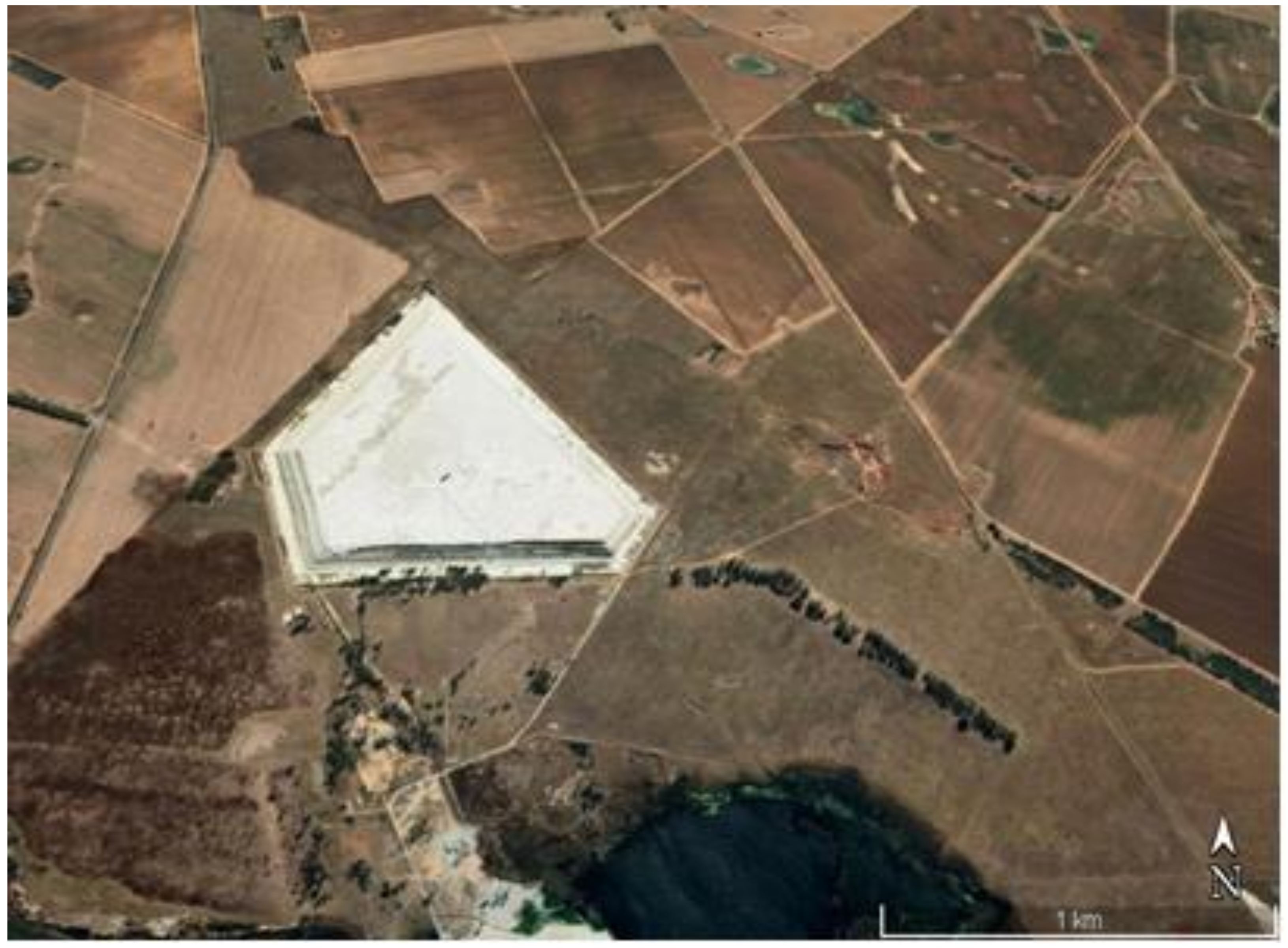
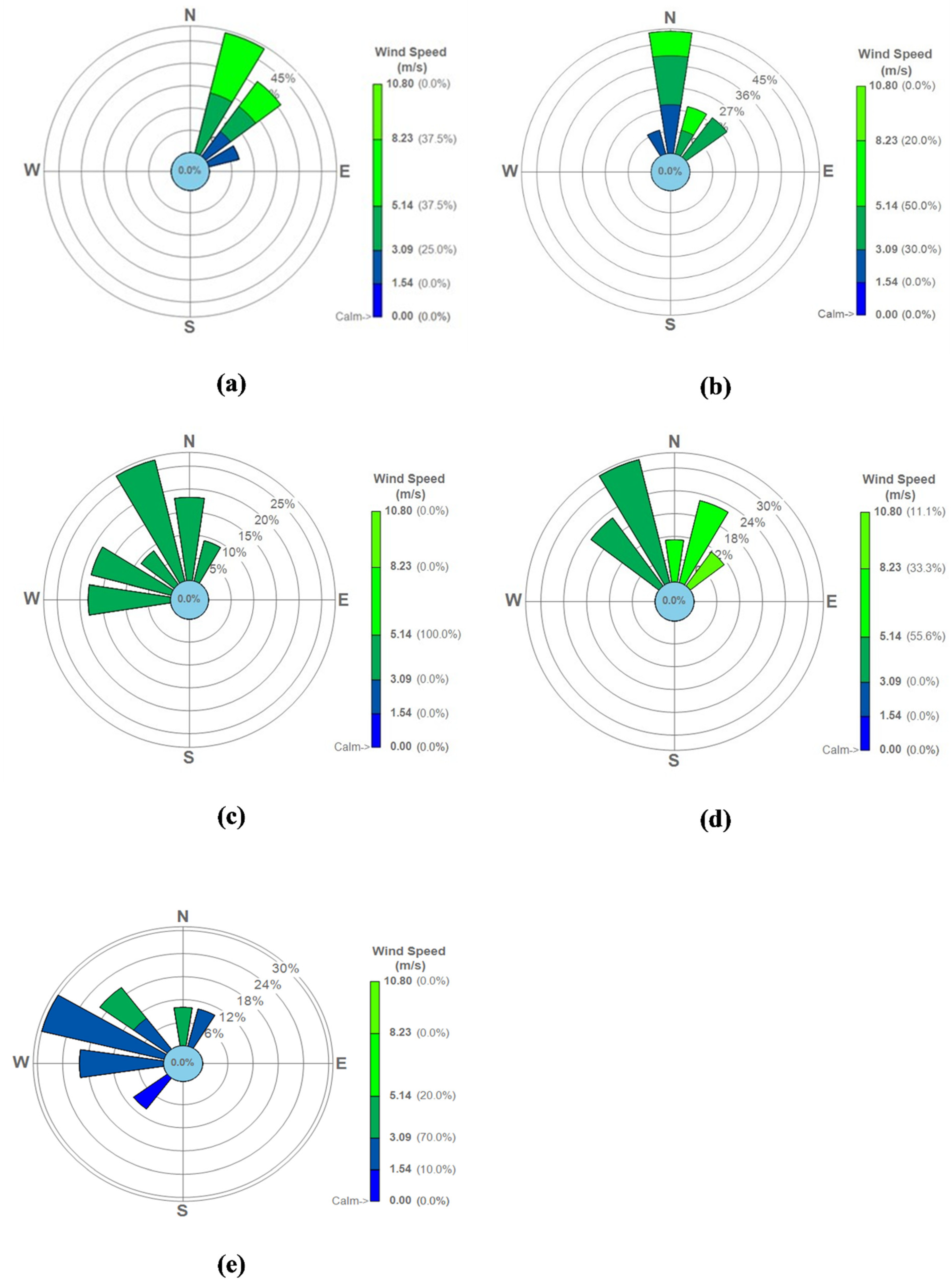
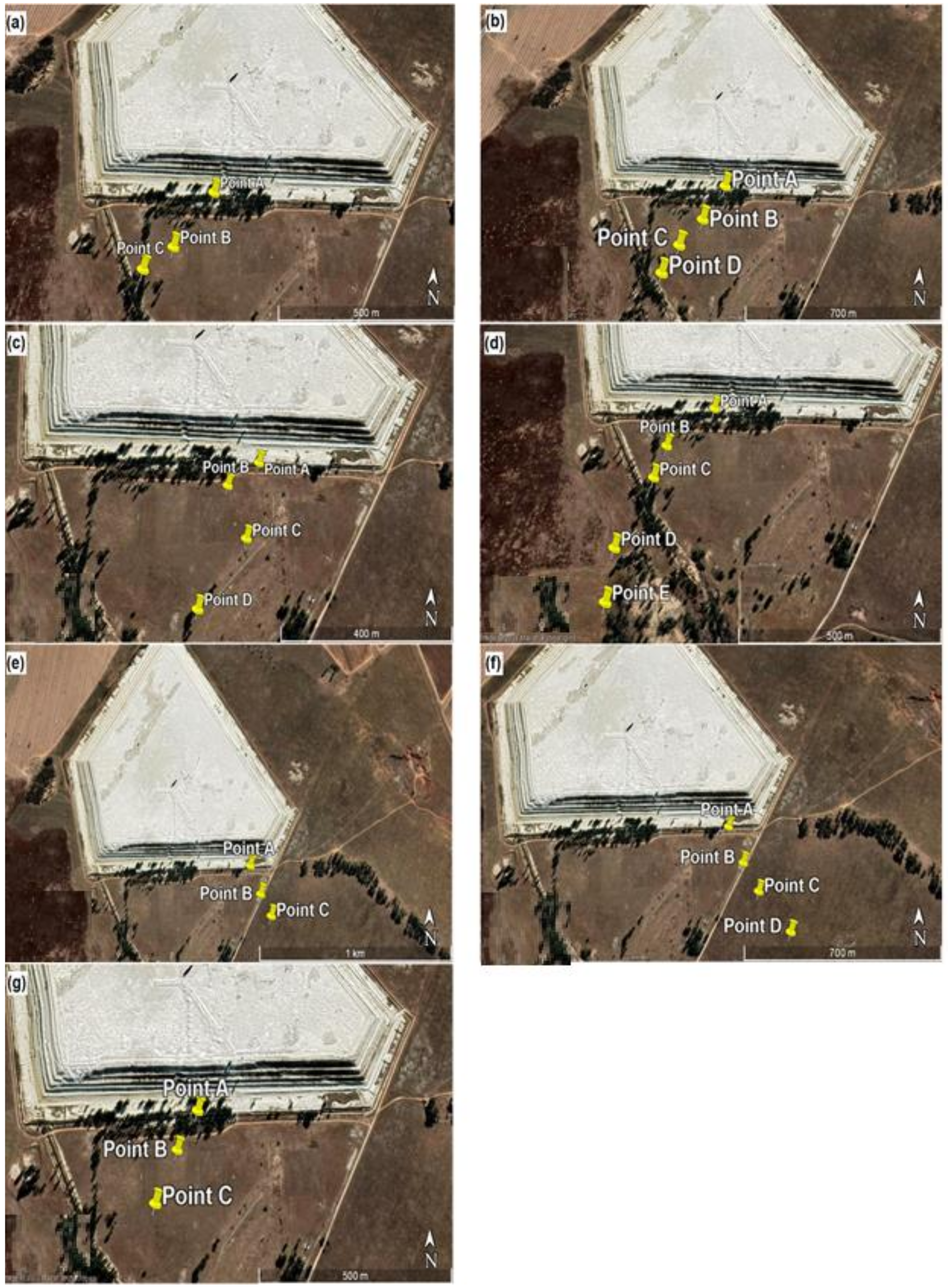
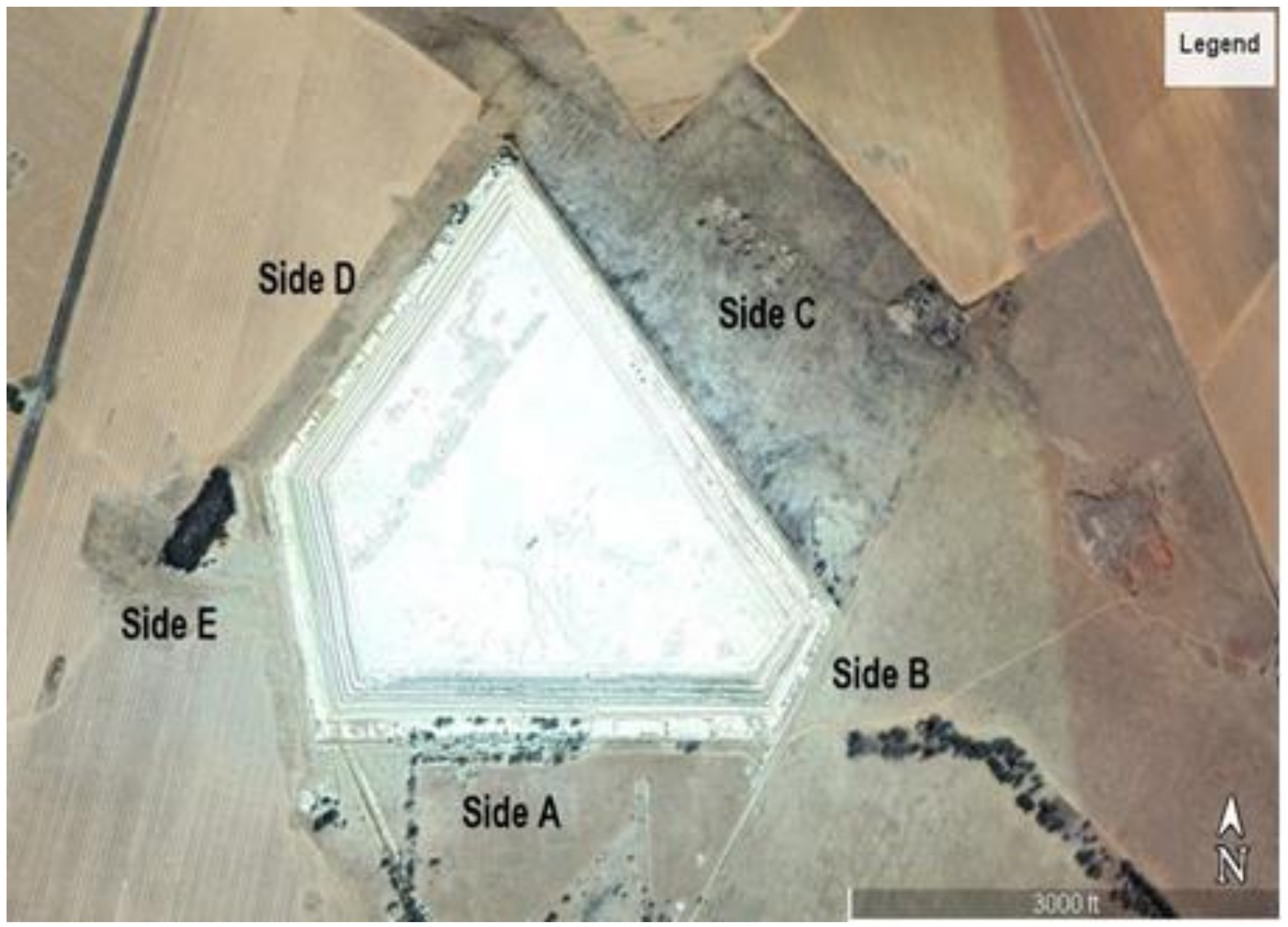
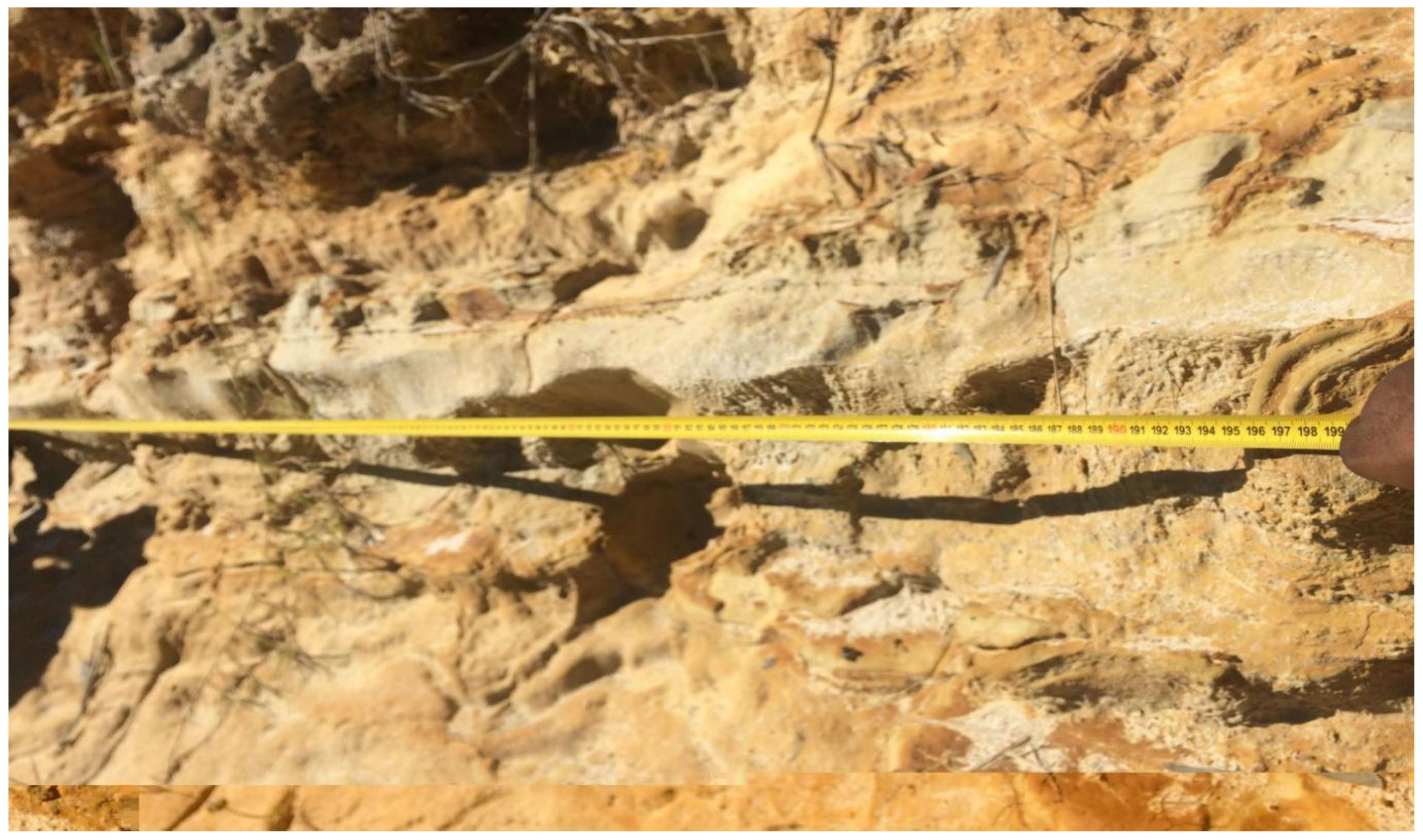
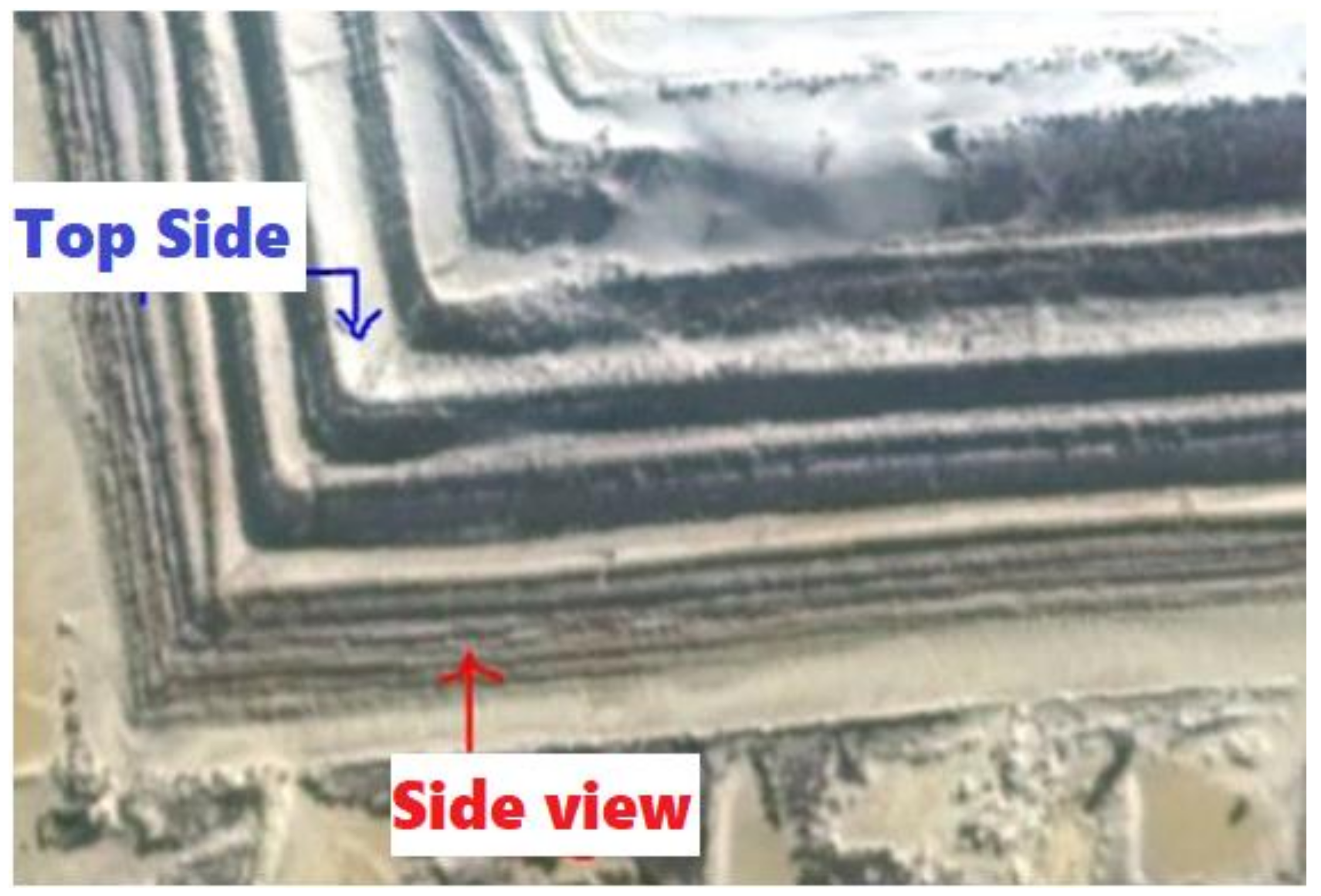
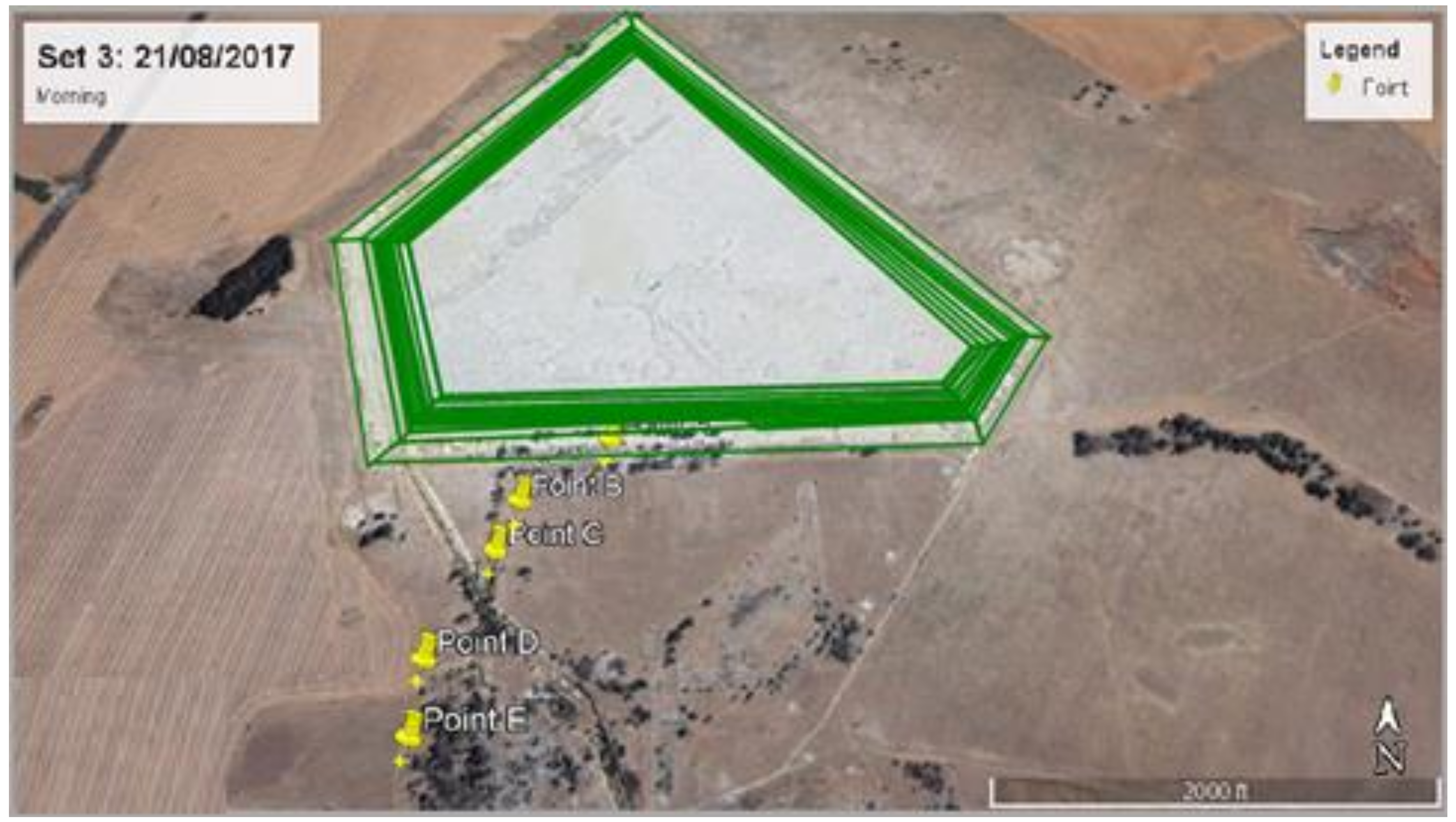
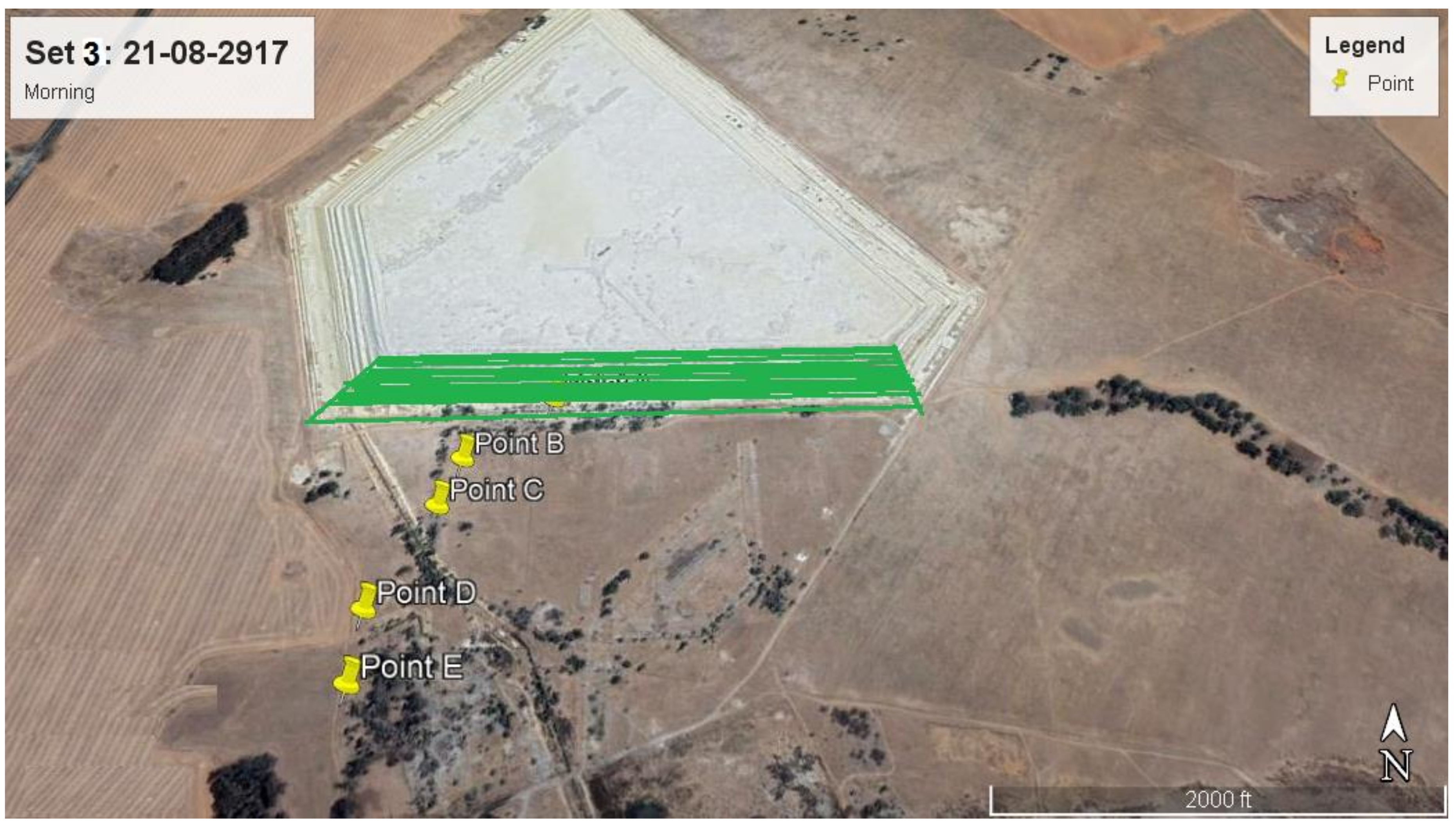
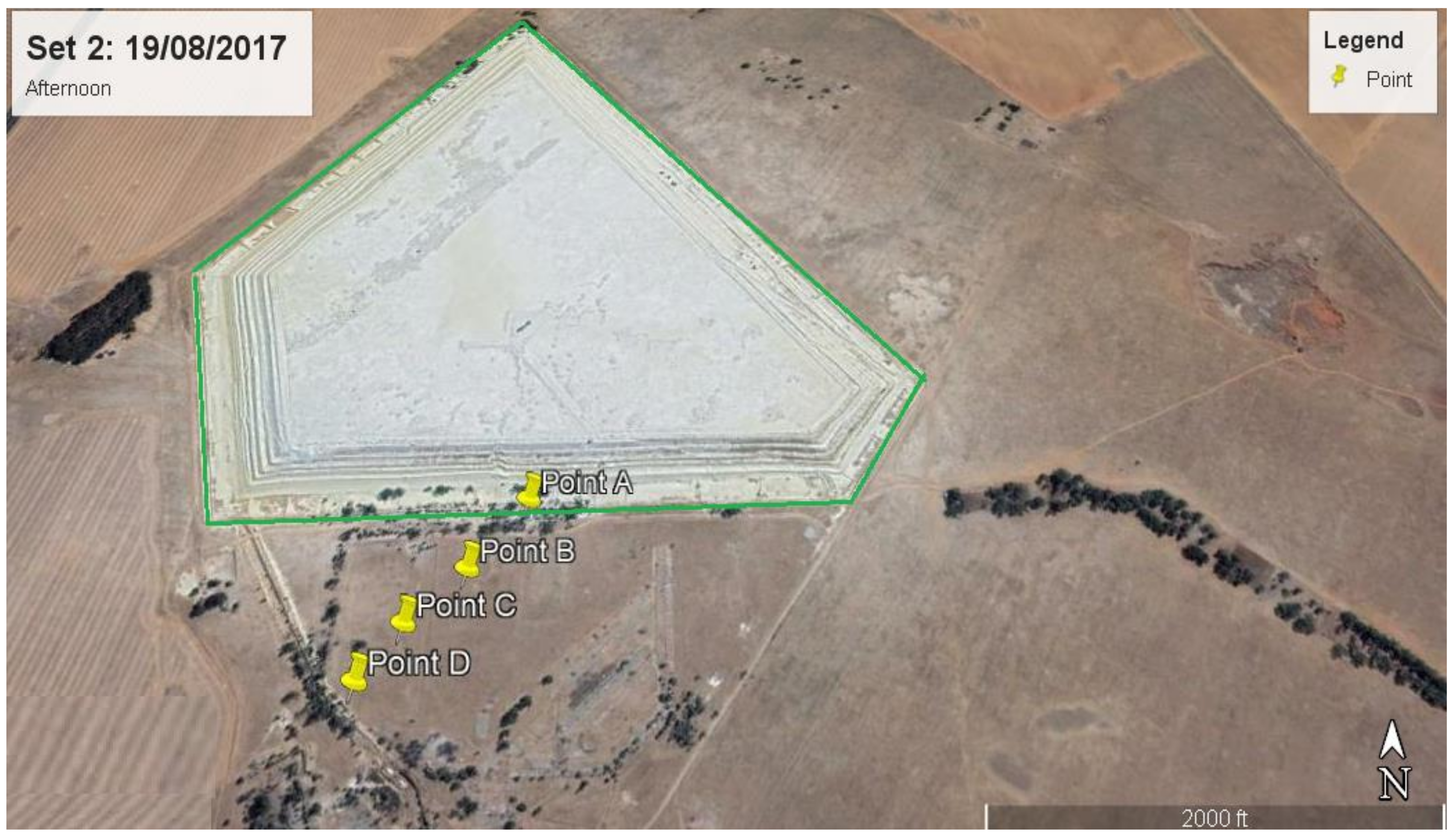

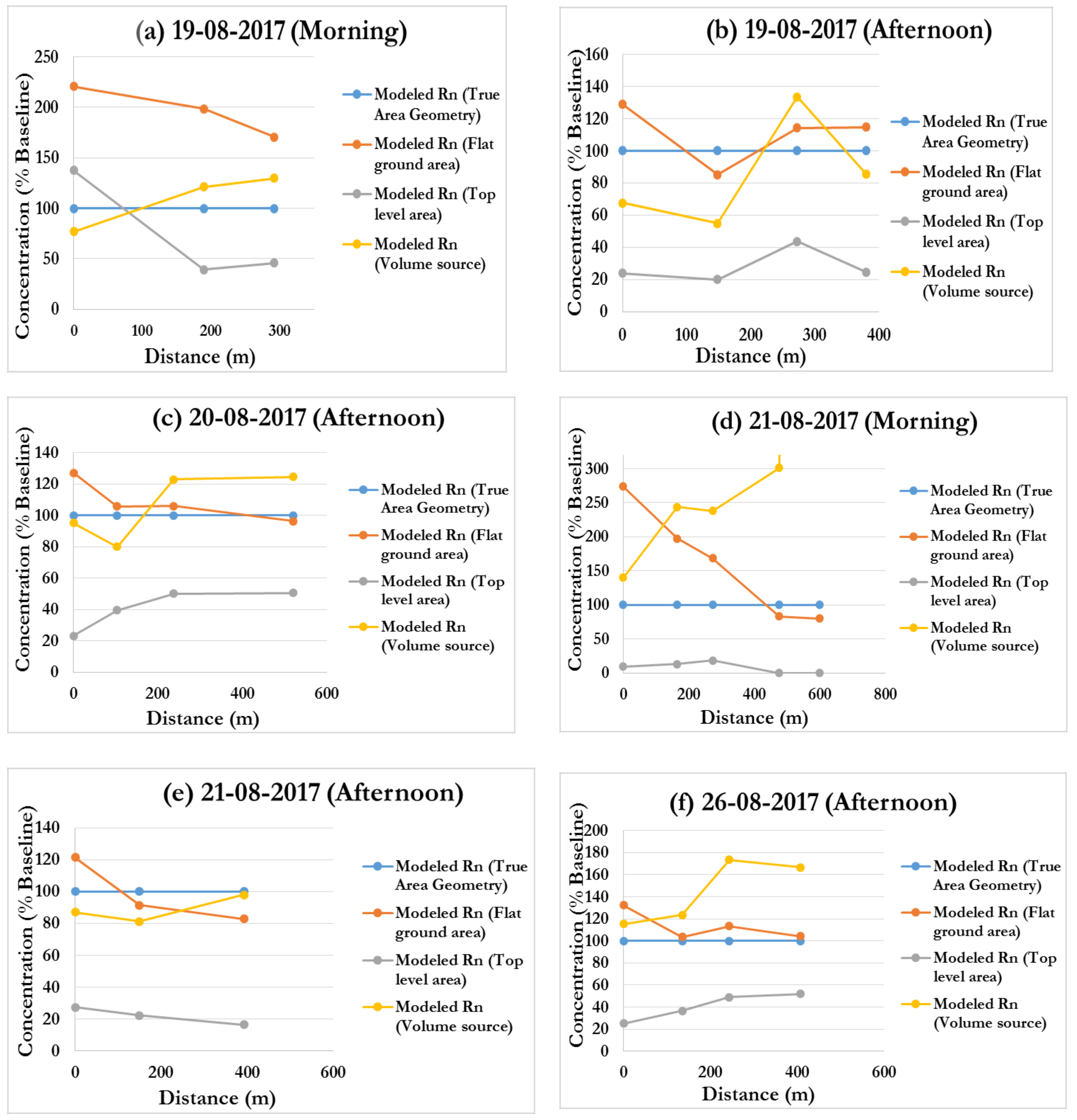
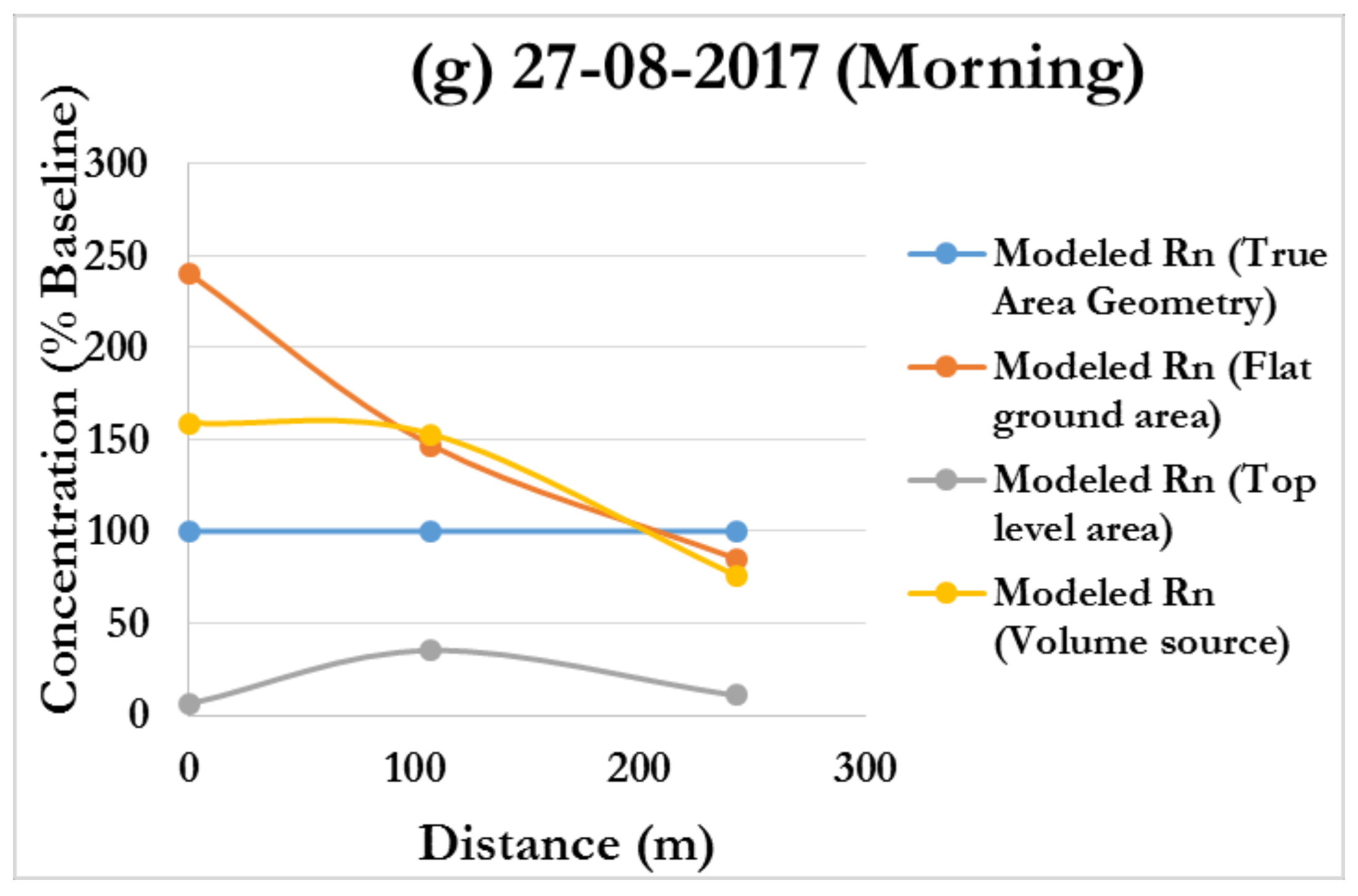
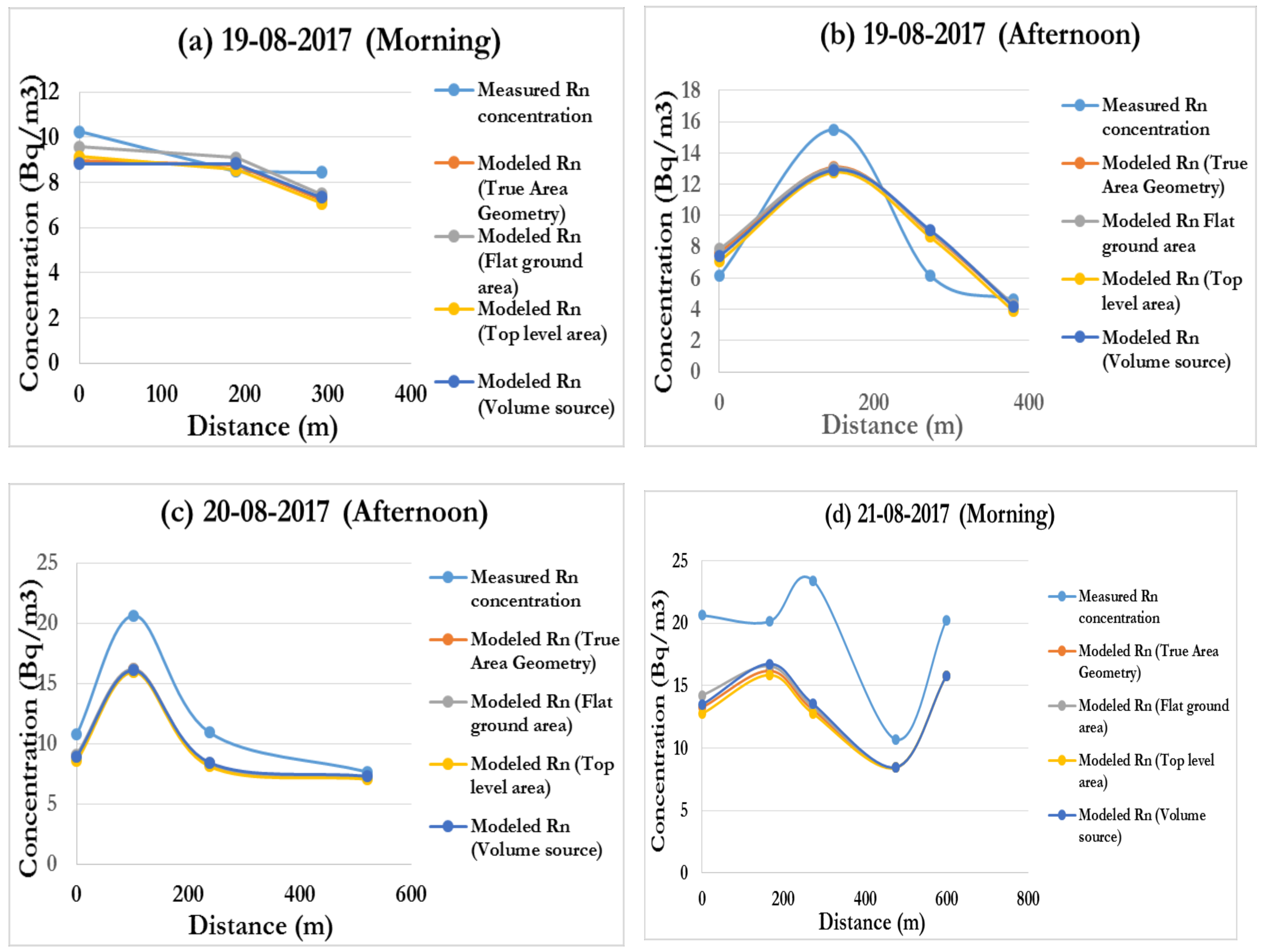
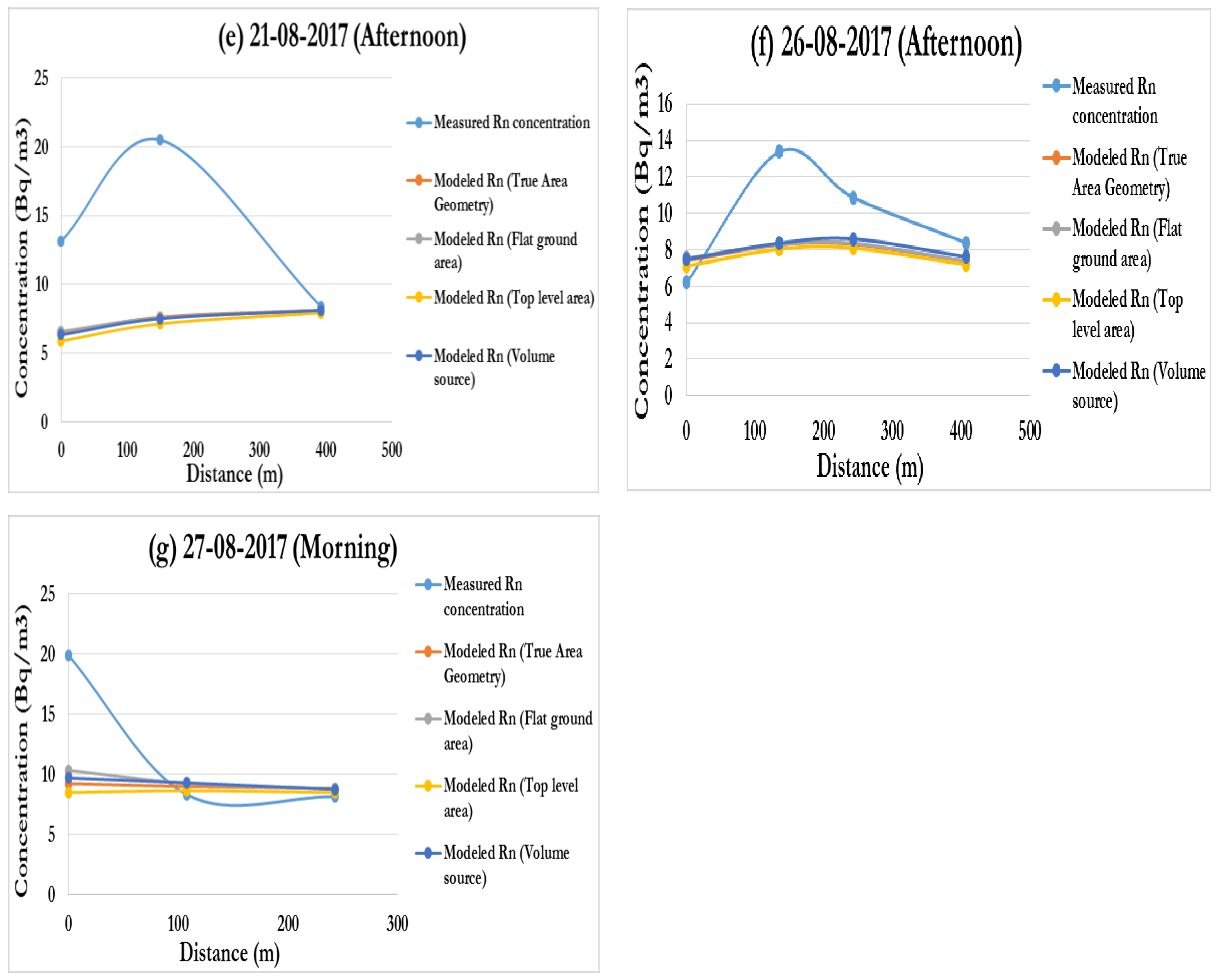
| 0364300 | 2017 | 0364300 | 2017 | |||||
|---|---|---|---|---|---|---|---|---|
| 17 | 819 | 1 | 241.000 | 5.5200 | 279.5 | 4 | 800.0 | 800.0 |
| 17 | 819 | 2 | 246.000 | 5.6800 | 279.2 | 4 | 800.0 | 800.0 |
| 17 | 819 | 3 | 245.000 | 5.5150 | 278.9 | 4 | 800.0 | 800.0 |
| 17 | 819 | 4 | 250.000 | 4.9550 | 278.3 | 4 | 800.0 | 800.0 |
| 17 | 819 | 5 | 259.000 | 4.3900 | 277.7 | 4 | 800.0 | 800.0 |
| 17 | 819 | 6 | 262.000 | 4.2900 | 277.3 | 5 | 410.9 | 410.9 |
| 17 | 819 | 7 | 260.000 | 4.1900 | 277.0 | 5 | 406.0 | 406.0 |
| 17 | 819 | 8 | 228.000 | 2.6950 | 277.5 | 3 | 1000.0 | 1000.0 |
| 17 | 819 | 9 | 219.000 | 2.9500 | 278.7 | 4 | 800.0 | 800.0 |
| 17 | 819 | 10 | 223.000 | 4.9500 | 280.8 | 4 | 800.0 | 800.0 |
| 17 | 819 | 11 | 219.000 | 5.2800 | 282.7 | 4 | 800.0 | 800.0 |
| 17 | 819 | 12 | 207.000 | 5.3350 | 284.9 | 4 | 800.0 | 800.0 |
| 17 | 819 | 13 | 209.000 | 5.0450 | 286.9 | 3 | 1000.0 | 1000.0 |
| 17 | 819 | 14 | 211.000 | 3.0630 | 288.9 | 1 | 1800.0 | 1800.0 |
| 17 | 819 | 15 | 216.000 | 2.7000 | 289.9 | 2 | 1400.0 | 1400.0 |
| 17 | 819 | 16 | 228.000 | 2.3600 | 290.4 | 2 | 1400.0 | 1400.0 |
| 17 | 819 | 17 | 221.000 | 2.5650 | 290.2 | 3 | 1000.0 | 1000.0 |
| 17 | 819 | 18 | 221.000 | 3.0050 | 289.3 | 5 | 343.9 | 343.9 |
| 17 | 819 | 19 | 211.000 | 3.0400 | 287.0 | 6 | 191.8 | 191.8 |
| 17 | 819 | 20 | 221.000 | 3.1300 | 284.6 | 6 | 194,7 | 194.7 |
| 17 | 819 | 21 | 270.000 | 2.9900 | 282.9 | 6 | 190.3 | 190.3 |
| 17 | 819 | 22 | 264.000 | 3.9450 | 282.6 | 5 | 394.0 | 394.0 |
| 17 | 819 | 23 | 255.000 | 5.9450 | 282.3 | 4 | 800.0 | 800.0 |
| 17 | 819 | 24 | 55.000 | 6.5250 | 282.0 | 5 | 506.7 | 506.7 |
| Tailing Side | Tape Length (m) | String Length (m) | Correction Factor (String/Tape) |
|---|---|---|---|
| Side A | 2.00 | 2.45 | 1.23 |
| Side B | 2.00 | 2.48 | 1.24 |
| Side C | 2.00 | 2.54 | 1.27 |
| Side D | 2.00 | 2.63 | 1.32 |
| Side E | 2.00 | 2.47 | 1.24 |
| Average | 2.00 | 2.51 | 1.26 |
| Side | Area Flux (Bq s−1 m−2) | Area (Google Earth) (m2) | Virtual Point Emission Rate (Bq s−1) |
|---|---|---|---|
| A | 0.102 | 05 | 4 |
| B | 0.102 | 4 | 3 |
| C | 0.102 | 5 | 4 |
| D | 0.102 | 5 | 4 |
| E | 0.102 | 4 | 3 |
| Pasquill Stability Category | p | q |
|---|---|---|
| A (1) | 209 | 0.89 |
| B (2) | 155 | 0.90 |
| C (3) | 103 | 0.92 |
| D (4) | 68 | 0.92 |
| E (5) | 51 | 0.92 |
| F (6) | 34 | 0.92 |
| Hour | Pasquill Stability Category | Side Length, S (m) | 1/q | Lateral Virtual Distance xy (km) | Lateral Virtual Distance xy (m) | Emission Height (m) | ||
|---|---|---|---|---|---|---|---|---|
| Side A | ||||||||
| 13 | 2 | 346 | 80.52 | 0.52 | 1.11 | 0.49 | 485.68 | 14 |
| 14 | 1 | 346 | 80.52 | 0.39 | 1.12 | 0.34 | 342.16 | 14 |
| 15 | 2 | 346 | 80.52 | 0.52 | 1.11 | 0.49 | 485.68 | 14 |
| 16 | 2 | 346 | 80.52 | 0.52 | 1.11 | 0.49 | 485.68 | 14 |
| Side B | ||||||||
| 13 | 2 | 148 | 34.36 | 0.22 | 1.11 | 0.19 | 188.94 | 75 |
| 14 | 1 | 148 | 34.36 | 0.16 | 1.12 | 0.13 | 131.42 | 75 |
| 15 | 2 | 148 | 34.36 | 0.22 | 1.11 | 0.19 | 188.94 | 75 |
| 16 | 2 | 148 | 34.36 | 0.22 | 1.11 | 0.19 | 188.94 | 75 |
| Side C | ||||||||
| 13 | 2 | 357 | 83.04 | 0.54 | 1.11 | 0.50 | 502.56 | 75 |
| 14 | 1 | 357 | 83.04 | 0.40 | 1.12 | 0.35 | 354.22 | 75 |
| 15 | 2 | 357 | 83.04 | 0.54 | 1.11 | 0.50 | 502.56 | 75 |
| 16 | 2 | 357 | 83.04 | 0.54 | 1.11 | 0.50 | 502.56 | 75 |
| Side D | ||||||||
| 13 | 2 | 328 | 76.22 | 0.49 | 1.11 | 0.46 | 457.01 | 75 |
| 14 | 1 | 328 | 76.22 | 0.36 | 1.12 | 0.32 | 321.70 | 75 |
| 15 | 2 | 328 | 76.22 | 0.49 | 1.11 | 0.46 | 457.01 | 75 |
| 16 | 2 | 328 | 76.22 | 0.49 | 1.11 | 0.46 | 457.01 | 75 |
| Side E | ||||||||
| 13 | 2 | 265 | 61.71 | 0.40 | 1.11 | 0.36 | 362 | 14 |
| 14 | 1 | 265 | 61.71 | 0.30 | 1.12 | 0.25 | 254 | 14 |
| 15 | 2 | 265 | 61.71 | 0.40 | 1.11 | 0.36 | 362 | 14 |
| 16 | 2 | 265 | 61.71 | 0.40 | 1.11 | 0.36 | 362 | 14 |
| Date/Time | Receptor Point | Co-Ordinates | Modelled Rn Concentrations (Bq/m3) | |||
|---|---|---|---|---|---|---|
| True Geometry | Flat Ground-Level Area | Top Level Area | Volume Source | |||
| 19-08-2017: Day 1 morning | ||||||
| 09:30 | A | 27°50′11″ S, 26°40′1″ E | 0.51 | 1.10 | 0.07 | 0.39 |
| 11:12 | B | 27°50′16″ S, 26°39′57″ E | 0.33 | 0.65 | 0.13 | 0.40 |
| 12:00 | C | 27°50′18″ S, 26°39′54″ E | 0.33 | 0.57 | 0.15 | 0.43 |
| Day 1 afternoon | ||||||
| 13:32 | A | 27°50′11″ S, 26°40′4″ E | 0.73 | 0.94 | 0.18 | 0.50 |
| 14:30 | B | 27°50′15″ S, 26°40′1″ E | 0.42 | 0.36 | 0.084 | 0.23 |
| 15:26 | C | 27°50′18″ S, 26°39′58″ E | 0.49 | 0.56 | 0.21 | 0.66 |
| 16:12 | D | 27°50′21″ S, 26°39′56”E | 0.47 | 0.54 | 0.12 | 0.40 |
| 20-08-2017: Day 2 afternoon | ||||||
| 13:08 | A | 27°50′11″ S, 26°40′10″ E | 0.53 | 0.68 | 0.12 | 0.51 |
| 13:54 | B | 27°50′13″ S, 26°40′7″ E | 0.38 | 0.40 | 0.15 | 0.31 |
| 14:50 | C | 27°50′17″ S, 26°40′9″ E | 0.44 | 0.47 | 0.22 | 0.54 |
| 15:49 | D | 27°50′22″ S, 26°40′5″ E | 0.32 | 0.31 | 0.16 | 0.40 |
| 21-08-2017: Day 3 morning | ||||||
| 07:39 | A | 27°50′11″ S, 26°40′0″ E | 0.56 | 1.50 | −2 | 0.79 |
| 08:35 | B | 27°50′15″ S, 26°39′56″ E | 0.39 | 0.76 | −2 | 0.94 |
| 09:25 | C | 27°50′18″ S, 26°39′54″ E | 0.35 | 0.60 | −2 | 0.84 |
| 10:28 | D | 27°50′24″ S, 26°39′51″ E | −2 | −3 | −6 | −2 |
| 11:14 | E | 27°50′28″ S, 26°39′51″ E | −5 | −5 | 0 | −3 |
| Day 3 afternoon | ||||||
| 13:00 | A | 27°50′10″ S, 26°40′22″ E | 0.75 | 0.91 | 0.21 | 0.65 |
| 13:52 | B | 27°50′12″ S, 26°40′27″ E | 0.62 | 0.57 | 0.14 | 0.51 |
| 15:24 | C | 27°50′15″ S, 26°40′35″ E | 0.22 | 0.18 | −2 | 0.22 |
| 26-08-2017: Day 4 afternoon | ||||||
| 13:19 | A | 27°50′11″ S, 26°40′18″ E | 0.41 | 0.55 | 0.10 | 0.48 |
| 14:12 | B | 27°50′15″ S, 26°40′20″ E | 0.37 | 0.39 | 0.14 | 0.46 |
| 15:04 | C | 27°50′18″ S, 26°40′22″ E | 0.41 | 0.46 | 0.20 | 0.71 |
| 16:04 | D | 27°50′22″ S, 26°40′26″ E | 0.37 | 0.39 | 0.19 | 0.62 |
| 27-08-2017: Day 5 morning | ||||||
| 08:02 | A | 27°50′11″ S, 26°40′4″ E | 0.79 | 1.90 | −2 | 1.2 |
| 08:50 | B | 27°50′14″ S, 26°40′2″ E | 0.55 | 0.81 | 0.20 | 0.85 |
| 09:43 | C | 27°50′18″ S, 26°40′0″ E | 0.40 | 0.34 | 4.3 | 0.30 |
| Receptor Point | Co-Ordinates | Side A (Bq m−3) | Side B (Bq m−3) | Side C (Bq m−3) | Side D (Bq m−3) | Side E (Bq m−3) | Total (Bq m−3) |
|---|---|---|---|---|---|---|---|
| A | 27°50′11″ S, 26°40′0″ E | 0.41 | 0 | −2 | −4 | 0 | 0.46 |
| B | 27°50′15″ S, 26°39′56″ E | 0.19 | 0 | −5 | 0.11 | 0 | 0.30 |
| C | 27°50′18″ S, 26°39′54″ E | 0.15 | 0 | −4 | 0.10 | 0 | 0.25 |
| D | 27°50′24″ S, 26°39′51″ E | −4 | 0 | 0 | −4 | 0.01 | 0.01 |
| E | 27°50′28″ S, 26°39′51″ E | −6 | 0 | 0 | −6 | −5 | −5 |
| Receptor Point | Co-Ordinates | Side A (%) | Side B (%) | Side C (%) | Side D (%) | Side E (%) | Total (%) |
|---|---|---|---|---|---|---|---|
| A | 27°50′11″ S, 26°40′0″ E | 81 | 0 | 18.97 | 0.13 | 0 | 100 |
| B | 27°50′15″ S, 26°39′56″ E | 64.7 | 0 | 0.03 | 35.27 | 0 | 100 |
| C | 27°50′18″ S, 26°39′54″ E | 60.46 | 0 | 0.14 | 39.4 | 0 | 100 |
| D | 27°50′24″ S, 26°39′51″ E | 5.24 | 0 | 0 | 2.62 | 92.14 | 100 |
| E | 27°50′28″ S, 26°39′51″ E | 1.66 | 0 | 0 | 2.37 | 95.97 | 100 |
| Receptor Point | Co-Ordinates | Side A (Bq m−3) | Side B (Bq m−3) | Side C (Bsq m−3) | Side D (Bq m−3) | Side E (Bq m−3) | Total (Bq m−3) |
|---|---|---|---|---|---|---|---|
| A | 27°50′11″ S, 26°40′18″ E | 0.22 | 0 | 0.06 | −3 | 0 | 0.29 |
| B | 27°50′15″ S, 26°40′20″ E | 0.14 | −4 | 0.07 | −3 | 0 | 0.21 |
| C | 27°50′18″ S, 26°40′22″ E | 0.14 | 0 | −3 | 0.041 | −5 | 0.19 |
| D | 27°50′22″ S, 26°40′26″ E | 0.11 | −5 | 0.01 | 0.039 | −4 | 0.16 |
| Receptor Point | Co-Ordinates | Side A (%) | Side B (%) | Side C (%) | Side D (%) | Side E (%) | Total (%) |
|---|---|---|---|---|---|---|---|
| A | 27°50′11″ S, 26°40′18″ E | 77.25 | 0 | 21.5 | 1.25 | 0 | 100 |
| B | 27°50′15″ S, 26°40′20″ E | 66.40 | 0.06 | 30.58 | 2.96 | 0 | 100 |
| C | 27°50′18″ S, 26°40′22″ E | 73.67 | 0 | 4.42 | 21.90 | 0.01 | 100 |
| D | 27°50′22″ S, 26°40′26″ E | 69.33 | 0.06 | 6.29 | 24.20 | 0.12 | 100 |
| Date/Time | Receptor Point | Co-Ordinates | Modelled Rn Concentrations (Bq m−3) | |||
|---|---|---|---|---|---|---|
| True Geometry | Flat Ground Area | Top Level Area | Volume Source | |||
| 19-08-2017 Morning | ||||||
| 09:30 | A | 27°50′11″ S, 26°40′1″ E | 0.574 | 1.189 | 0.766 | 0.458 |
| 11:12 | B | 27°50′16″ S, 26°39′57″ E | 0.326 | 0.648 | 0.128 | 0.396 |
| 12:00 | C | 27°50′18″ S, 26°39′54″ E | 0.337 | 0.573 | 0.156 | 0.437 |
| Afternoon | ||||||
| 13:32 | A | 27°50′11″ S, 26°40′4″ E | 0.821 | 1.032 | 0.262 | 0.583 |
| 14:30 | B | 27°50′15″ S, 26°40′1″ E | 0.436 | 0.373 | 0.097 | 0.245 |
| 15:26 | C | 27°50′18″ S, 26°39′58″ E | 0.570 | 0.640 | 0.293 | 0.735 |
| 16:12 | D | 27°50′21″ S, 26°39′56″ E | 0.472 | 0.541 | 0.119 | 0.405 |
| 20-08-2017 Afternoon | ||||||
| 13:08 | A | 27°50′11″ S, 26°40′10″ E | 0.575 | 0.719 | 0.164 | 0.548 |
| 13:54 | B | 27°50′13″ S, 26°40′7″ E | 0.392 | 0.414 | 0.161 | 0.316 |
| 14:50 | C | 27°50′17″ S, 26°40′9″ E | 0.472 | 0.498 | 0.252 | 0.573 |
| 15:49 | D | 27°50′22″ S, 26°40′5″ E | 0.367 | 0.355 | 0.208 | 0.446 |
| 21-08-2017 Morning | ||||||
| 07:39 | A | 27°50′′11″ S, 26°40′0″ E | 0.566 | 1.542 | 0.057 | 0.792 |
| 08:35 | B | 27°50′15″ S, 26°39′56″ E | 0.433 | 0.809 | 0.097 | 0.989 |
| 09:25 | C | 27°50′18″ S, 26°39′54″ E | 0.402 | 0.644 | 0.113 | 0.889 |
| 10:28 | D | 27°50′24″ S, 26°39′51″ E | 0.012 | 0.010 | 5.43E-6 | 0.034 |
| 11:14 | E | 27°50′28″ S, 26°39′51″ E | 0.000 | 0.000 | 0.000 | 0.008 |
| Afternoon | ||||||
| 13:00 | A | 27°50′10″ S, 26°40′22″ E | 0.796 | 0.956 | 0.252 | 0.698 |
| 13:52 | B | 27°50′12″ S, 26°40′27″ E | 0.678 | 0.623 | 0.192 | 0.561 |
| 15:24 | C | 27°50′15″ S, 26°40′35″ E | 0.232 | 0.194 | 0.046 | 0.228 |
| 26-08-2017 Afternoon | ||||||
| 13:19 | A | 27°50′11″ S, 26°40′18″ E | 0.559 | 0.692 | 0.249 | 0.623 |
| 14:12 | B | 27°50′15″ S, 26°40′20″ E | 0.449 | 0.462 | 0.212 | 0.536 |
| 15:04 | C | 27°50′18″ S, 26°40′22″ E | 0.422 | 0.477 | 0.213 | 0.722 |
| 16:04 | D | 27°50′22″ S, 26°40′26″ E | 0.382 | 0.397 | 0.203 | 0.630 |
| 27-08-2017 Morning | ||||||
| 08:02 | A | 27°50′11″ S, 26°40′4″ E | 0.843 | 1.949 | 0.103 | 1.307 |
| 08:50 | B | 27°50′14″ S, 26°40′2″ E | 0.589 | 0.849 | 0.229 | 0.882 |
| 09:43 | C | 27°50′18″ S, 26°40′0″ E | 0.398 | 0.340 | 0.043 | 0.303 |
| Date | Receptor Points | Distance (m) | ISC-PRIME to ISC3ST Concentration Ratios | |||
|---|---|---|---|---|---|---|
| True Geometry Area | Flat Ground Area | Top Level Area | Volume Source | |||
| 19-08-2017 Morning | ||||||
| 09:30 | A | 0 | 1.129 | 1.058 | 1.093 | 1.167 |
| 11:12 | B | 189.2 | 1.001 | 1.001 | 1.003 | 1.001 |
| 12:00 | C | 291.8 | 1.008 | 1.004 | 1.016 | 1.006 |
| Afternoon | ||||||
| 13:32 | A | 0 | 1.118 | 1.092 | 1.497 | 1.175 |
| 14:30 | B | 148.3 | 1.029 | 1.034 | 1.146 | 1.053 |
| 15:26 | C | 272.0 | 1.159 | 1.139 | 1.364 | 1.119 |
| 16:12 | D | 379.6 | 1.007 | 1.006 | 1.029 | 1.008 |
| 20-08-2017 Afternoon | ||||||
| 13:08 | A | 0 | 1.075 | 1.059 | 1.325 | 1.079 |
| 13:54 | B | 102.6 | 1.027 | 1.026 | 1.068 | 1.034 |
| 14:50 | C | 237.7 | 1.074 | 1.070 | 1.148 | 1.060 |
| 15:49 | D | 521.0 | 1.142 | 1.148 | 1.281 | 1.114 |
| 21-08-2017 Morning | ||||||
| 07:39 | A | 0 | 1.006 | 1.002 | 1.067 | 1.005 |
| 08:35 | B | 164.9 | 1.120 | 1.061 | 1.909 | 1.049 |
| 09:25 | C | 272.5 | 1.135 | 1.080 | 1.740 | 1.057 |
| 10:28 | D | 475.1 | 1.019 | 1.022 | 1.000 | 1.006 |
| 11:14 | E | 598.6 | 1.000 | 1.000 | 1.000 | 1.000 |
| Afternoon | ||||||
| 13:00 | A | 0 | 1.062 | 1.051 | 1.228 | 1.072 |
| 13:52 | B | 149.9 | 1.085 | 1.093 | 1.383 | 1.105 |
| 15:24 | C | 392.5 | 1.044 | 1.053 | 1.267 | 1.045 |
| 26-08-2017 Afternoon | ||||||
| 13:19 | A | 0 | 1.349 | 1.264 | 2.391 | 1.303 |
| 14:12 | B | 135.1 | 1.203 | 1.196 | 1.558 | 1.164 |
| 15:04 | C | 242.7 | 1.033 | 1.029 | 1.068 | 1.019 |
| 16:04 | D | 407.6 | 1.028 | 1.027 | 1.054 | 1.017 |
| 27-08-2017 Morning | ||||||
| 08:02 | A | 0 | 1.069 | 1.029 | 2.123 | 1.044 |
| 08:50 | B | 107.6 | 1.062 | 1.042 | 1.175 | 1.040 |
| 09:43 | C | 242.7 | 1.000 | 1.000 | 1.000 | 1.000 |
| Day/Time | Receptor Points | Distance (m) | Measured Rn Concentration (Downwind) (Bq/m3) | Background Rn Concentration (Upwind) (Bq/m3) |
|---|---|---|---|---|
| 19-08-2017 Morning | ||||
| 09:30 | A | 0 | 10.3 | 8.437 |
| 11:12 | B | 189.2 | 8.5 | 8.437 |
| 12:00 | C | 291.8 | 8.4 | 6.907 |
| Afternoon | ||||
| 13:32 | A | 0 | 6.1 | 6.906 |
| 14:30 | B | 148.3 | 15.5 | 12.675 |
| 15:26 | C | 272.0 | 6.2 | 8.432 |
| 16:12 | D | 379.6 | 4.6 | 3.796 |
| 20-08-2017 Afternoon | ||||
| 13:08 | A | 0 | 10.8 | 8.436 |
| 13:54 | B | 102.6 | 20.6 | 15.787 |
| 14:50 | C | 237.7 | 10.9 | 7.902 |
| 15:49 | D | 521 | 7.7 | 6.905 |
| 21-08-2017 Morning | ||||
| 07:39 | A | 0 | 20.6 | 12.703 |
| 08:35 | B | 164.9 | 20.1 | 15.799 |
| 09:25 | C | 272.5 | 23.4 | 12.682 |
| 10:28 | D | 475.1 | 10.7 | 8.423 |
| 11:14 | E | 598.6 | 20.3 | 15.776 |
| Afternoon | ||||
| 13:00 | A | 0 | 13.1 | 5.678 |
| 13:52 | B | 149.9 | 20.5 | 6.991 |
| 15:24 | C | 392.5 | 8.4 | 7.891 |
| 26-08-2017 Afternoon | ||||
| 13:19 | A | 0 | 6.2 | 6.996 |
| 14:12 | B | 135.1 | 13.4 | 7.903 |
| 15:04 | C | 242.7 | 10.9 | 7.895 |
| 16:04 | D | 407.6 | 8.38 | 6.993 |
| 27-08-2017 Morning | ||||
| 08:02 | A | 0 | 19.9 | 8.430 |
| 08:50 | B | 107.6 | 8.3 | 8.432 |
| 09:43 | C | 242.7 | 8.1 | 8.433 |
Publisher’s Note: MDPI stays neutral with regard to jurisdictional claims in published maps and institutional affiliations. |
© 2022 by the authors. Licensee MDPI, Basel, Switzerland. This article is an open access article distributed under the terms and conditions of the Creative Commons Attribution (CC BY) license (https://creativecommons.org/licenses/by/4.0/).
Share and Cite
Komati, F.; Ntwaeaborwa, M.; Strydom, R. An In Toto Approach to Radon Dispersion Modelling from a South African Gold Mine Tailings. Int. J. Environ. Res. Public Health 2022, 19, 8201. https://doi.org/10.3390/ijerph19138201
Komati F, Ntwaeaborwa M, Strydom R. An In Toto Approach to Radon Dispersion Modelling from a South African Gold Mine Tailings. International Journal of Environmental Research and Public Health. 2022; 19(13):8201. https://doi.org/10.3390/ijerph19138201
Chicago/Turabian StyleKomati, Frank, Martin Ntwaeaborwa, and Rian Strydom. 2022. "An In Toto Approach to Radon Dispersion Modelling from a South African Gold Mine Tailings" International Journal of Environmental Research and Public Health 19, no. 13: 8201. https://doi.org/10.3390/ijerph19138201
APA StyleKomati, F., Ntwaeaborwa, M., & Strydom, R. (2022). An In Toto Approach to Radon Dispersion Modelling from a South African Gold Mine Tailings. International Journal of Environmental Research and Public Health, 19(13), 8201. https://doi.org/10.3390/ijerph19138201





